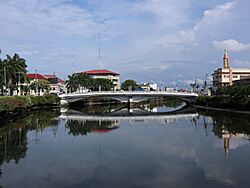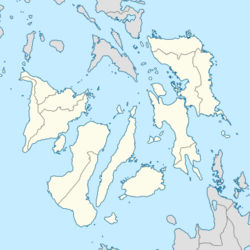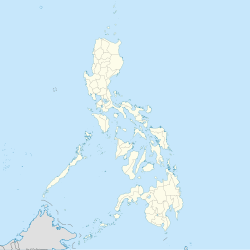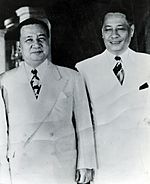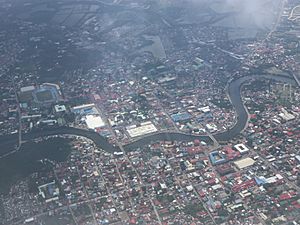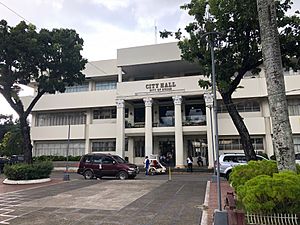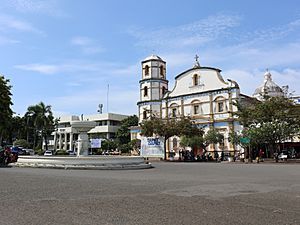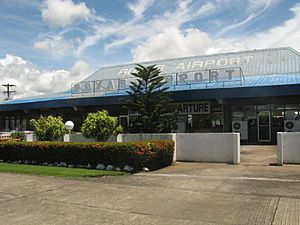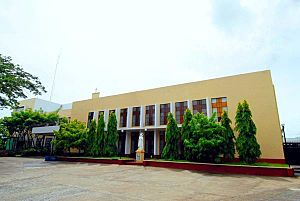Roxas City facts for kids
Quick facts for kids
Roxas City
|
|||
|---|---|---|---|
|
Component city
|
|||
| City of Roxas | |||
|
Clockwise from top: Roxas City Bridge over the Panay River, Sacred Heart of Jesus statue, Roxas City Bandstand, Manuel Roxas statue, Roxas Cathedral
|
|||
|
|||
| Nickname(s):
Seafood Capital of the Philippines
|
|||
| Anthem: Ang Banwa kong Pinalangga (The Town I Love) | |||
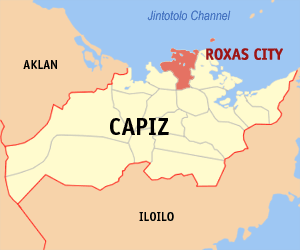
Map of Capiz with Roxas City highlighted
|
|||
|
OpenStreetMap
|
|||
| Country | Philippines | ||
| Region | Western Visayas | ||
| Province | Capiz | ||
| District | [[{{#property:P7938}} | — Lua error in Module:Wd at line 1804: attempt to index field 'wikibase' (a nil value).]] | ||
| Founded | 1569 | ||
| Cityhood | May 12, 1951 | ||
| Named for | Manuel Acuña Roxas | ||
| Barangays | 47 (see Barangays) | ||
| Government
|
|||
| • Type | Sangguniang Panlungsod | ||
| Area | |||
| • Total | 95.07 km2 (36.71 sq mi) | ||
| Elevation | 7.0 m (23.0 ft) | ||
| Highest elevation | 383 m (1,257 ft) | ||
| Lowest elevation | -2 m (−6.6 ft) | ||
| Population
(2020 census)
|
|||
| • Total | 179,292 | ||
| • Density | 1,885.89/km2 (4,884.44/sq mi) | ||
| • Households | 43,257 | ||
| Economy | |||
| • Income class | 2nd city income class | ||
| • Poverty incidence |
|
||
| • Revenue | ₱ 1,366 million (2022) | ||
| • Assets | ₱ 3,004 million (2022) | ||
| • Expenditure | ₱ 919.2 million (2022) | ||
| • Liabilities | ₱ 463.2 million (2022) | ||
| Service provider | |||
| • Electricity | Capiz Electric Cooperative (CAPELCO) | ||
| Time zone | UTC+8 (PST) | ||
| ZIP code |
5800
|
||
| PSGC |
[https://psa.gov.ph/classification/psgc/?q=psgc/barangays/{{#pro000®code={{&provcode=
|
||
| IDD : area code | +63 (0)36 | ||
| Native languages | Capisnon Hiligaynon Tagalog |
||
| Website | www |
||
Roxas City is a lively city in the Philippines. It is the capital of the province of Capiz. Roxas City is located on Panay Island in the Western Visayas region.
The city is famous for its seafood. People often call it the "Seafood Capital of the Philippines." This is because of the many fishponds and fresh seafood available. In 2020, about 179,292 people lived here. This makes it the most populated city in Capiz.
Roxas City was once known as the Municipality of Capiz. It became a city on May 12, 1951. The city was then renamed after Manuel Acuña Roxas. He was the fourth president of the Philippines. He was also the first president of the independent Third Philippine Republic.
Today, Roxas City is an important center for education, trade, and business in Northern Panay. It has won awards for being clean and tobacco-free. It is also recognized for good local government.
Contents
History of Roxas City
Spanish Rule (1569-1898)
In 1569, a Spanish captain named Diego de Artieda arrived in the area. He was sent by Miguel López de Legazpi. The first capital was in the town of Panay. Later, it moved to the current site of Roxas City. This new spot was closer to the sea and better for ships.
The Panay River flows through the city. It helped the land become fertile for farming and fishponds. In 1590, the Spanish navy used the port of Capiz as a safe place for ships. The town grew into a busy port. Stone houses were built, and the local leaders often married Spaniards. Their children became important people in the town.
In 1746, Capiz became the center of the local government. This separated it from Iloilo. In 1814, stone forts were built at Baybay Beach. This was to protect the town from attacks.
The construction of the Capiz Cathedral began in 1870. Local people were asked to help build it. The cathedral was finished in 1877. When the Philippine Revolution happened, the Spanish government in Capiz surrendered in 1898.
American Rule (Early 1900s)
After Spanish rule, the Philippines came under the control of the United States. In the early 1900s, American missionaries arrived. They helped set up schools and hospitals. One example is the Capiz Home School, which later became Filamer Christian University.
In 1917, the Capiz Trade School was founded. It taught skills like woodworking. Later, the Capiz High School was also opened. In 1926, the Culasi Port was built. This port helped ships travel between islands.
Becoming a City (1951)
Capiz officially became a city on May 12, 1951. This happened through a law supported by Ramón Acuña Arnaldo. President Elpidio Quirino approved the law. The town was then renamed Roxas City. This was to honor Manuel Roxas, who was the first president of the independent Philippines.
The first appointed mayor of Roxas City was Lorenzo Acuña Arnaldo. Later, he became the first elected mayor in 1959. The current mayor of Roxas City is Ronnie T. Dadivas, who was elected in 2019.
Geography and Climate
Roxas City is on the north-central coast of Panay Island. It is bordered by the Sibuyan Sea to the north. Other towns surround it to the south, west, and east.
The city is about 116 kilometers north of Iloilo City. It takes about 2 hours to travel by land to Iloilo City. Traveling from Manila to Roxas City takes about 50 minutes by plane.
Climate
Roxas City has a tropical climate. It generally has warm temperatures throughout the year. There are wet and dry seasons. The wet season usually brings more rain from June to November. The dry season is from December to May.
Barangays
The city of Roxas is divided into 47 smaller areas called barangays. These are like neighborhoods or villages. Each barangay has even smaller parts called puroks.
Most of these barangays are in the urban, or city, area. The rest are in rural, or countryside, areas.
- Adlawan
- Bago
- Balijuagan
- Banica
- Barangay 1
- Barangay 2
- Barangay 3
- Barangay 4
- Barangay 5
- Barangay 6
- Barangay 7
- Barangay 8
- Barangay 9
- Barangay 10
- Barangay 11
- Barra
- Bato
- Baybay
- Bolo
- Cabugao
- Cagay
- Cogon
- Culajao
- Culasi
- Dumolog
- Dayao
- Dinginan
- Gabu-an
- Inzo Arnaldo Village (Cadimahan)
- Jumaguicjic
- Lanot
- Lawa-an
- Li-ong
- Libas
- Loctugan
- Lonoy
- Milibili
- Mongpong
- Olotayan
- Punta Cogon
- Punta Tabuc
- San Jose
- Sibaguan
- Talon
- Tanque
- Tanza
- Tiza
Population and Language
In 2020, Roxas City had a population of 179,292 people. This means there were about 1,886 people living per square kilometer.
Languages Spoken
The main languages spoken in Roxas City are Capiznon and Hiligaynon. Many people also speak English and Tagalog.
Economy and Business
Roxas City is becoming a "Digital City." This means it is growing in technology and business services. The city gets its electricity from CAPELCO. Drinking water is supplied by the Metro Roxas Water District.
A large development called Pueblo de Panay is expanding the city's urban area. It includes restaurants, hotels, and the tall Sacred Heart of Jesus (Roxas, Capiz) statue. It also has Roxas City's first condominium and the Robinsons Place Roxas mall. Big companies like ePerformax Contact Centers and BPO have offices here.
Roxas City is seeing a "real estate boom." This means many fishponds are being turned into new neighborhoods and shopping areas.
The National Port of Culasi and Roxas Airport are the main ways to get to the city. Airlines like Philippine Airlines and Cebu Pacific have daily flights to Manila. Ships also connect Roxas City to other parts of the Philippines.
Farming and Fishing
Roxas City's economy is largely based on farming and fishing. These activities cover a big part of the city's land. Rice and melons are the main crops grown. Papaya and jackfruit trees are also common.
Seafood Production
As the "Seafood Capital," Roxas City exports seafood to countries like Taiwan, Japan, and the United States. Phillips Seafood Philippines Corporation has a processing plant here. Oyster and milkfish farms are common, using the natural bays and low-lying coastal areas.
Banking and Malls
Roxas City has more than 45 banks, including a branch of the Bangko Sentral ng Pilipinas. There are also 7 malls in the city. These include SM City, Robinsons, Gaisano Grand, and Citymalls.
Business Process Outsourcing (BPO)
BPO companies offer services like customer support and online tutorials. PETRA Academy provides online English lessons to Korean students. ePerformax Contact Center and BPO is the largest BPO company in the area. It employs over 1,000 people. Xilium is another BPO company with a branch in Roxas City.
City Infrastructure
Public Transportation
In Roxas City, people mostly travel by passenger jeepneys, metered taxis, and motorized tricycles. The Capiz Cabs are SUV-type taxis that can carry up to seven passengers. They serve the entire Panay Island. Pueblo de Panay Libot Vehicles are larger trucks used for transport within the Pueblo de Panay area.
Transport Terminals
Roxas City has two main transport terminals:
- Roxas City Integrated Terminal: Located in Pueblo de Panay, this terminal serves passengers traveling to and from Aklan and Iloilo provinces. It also handles buses going to Manila.
- Roxas City Eastern Terminal: This terminal in Banica serves passengers traveling to and from Iloilo province.
Roxas Airport
Roxas Airport (RXS) serves Roxas City and the province of Capiz. It is a Class 1 principal airport. The airport has daily flights to Manila by Cebu Pacific, Philippine Airlines, and Air Asia. In 2013, the government approved a budget to expand the airport. This included adding night landing facilities.
Port of Culasi
The Port of Culasi is an important port for Roxas City and Northern Panay. It has been a trading center since Spanish times. Currently, ships travel from Culasi to places like Romblon, Batangas, and Manila. The Philippine Coast Guard also has a station here. Two RORO (roll-on/roll-off) vessels, 2GO Travel and Starlite Ferries, operate from this port to Batangas.
Other Ports
- Port of Libas: This port is used by fishing vessels and is a center for trading seafood.
- Port of Banica: This port is a trading route to different parts of Masbate Island. It is believed to be where Captain Diego de Artieda first landed in 1569.
Communication Services
Roxas City has many communication services. These include landline phones, mobile phones, internet, and post offices. Major providers like Philippine Long Distance Telephone Company, Globe Telecom, Smart Communications, and Dito Telecommunity offer services here.
Convention Facilities
- El Circulo Convention Center: This is a modern convention center in Pueblo de Panay. It hosts weddings and other events. The University of the Philippines Visayas also holds classes here.
- Gerry Roxas Foundation Resource Center: Located at the Roxas City Center, this facility hosts meetings and conventions for government groups.
- CAP Auditorium: This venue hosts large events, cultural shows, and educational programs.
Sports Venues
- Villareal Stadium: This is the largest stadium in Western Visayas. Built in 1962, it has a 20,000-seat capacity. It includes an Olympic-sized swimming pool, a gym, and courts for various sports. It has hosted major sports events like the Palarong Pambansa.
- Dinggoy Roxas Civic Center: This center has a 5,000-seat capacity. It hosts regional and local basketball games and other events.
- Capiz Gymnasium: This gym can seat 6,000 people. It has hosted professional basketball games and other large events.
New Road Networks
The Roxas City Government is working on a Circumferential Road. This road will help traffic bypass the city center. It will make it easier for goods and people to travel to and from Culasi Port and nearby towns.
Parks and Plazas
Capiz Provincial Park
This park is in Barangay Tiza. It has many green areas and gardens. There are three monuments that show the history and culture of Roxas City. The park also has an outdoor theater and a platform for public events. It is a nice place for both locals and tourists.
Roxas City Plaza/Halaran Plaza
This park is in the middle of the city. One part is near the Panay River. It has the famous Roxas City Bandstand. This is where the agreement to make Capiz a city was signed. There is also a life-size chess plaza.
The other part of the plaza faces the Roxas City Hall. It used to have many pine trees. After a strong typhoon, some trees were lost. Here, you can find the Manuel Roxas Monument. Near it is the Panublion Museum. This museum, which used to be a water tank, tells the story of Roxas City's history.
La Playa de Roxas People's Park
This park is in Barangay Baybay, facing the Sibuyan Sea. It has a colorful dancing fountain. There is a beach where people can swim. The park also has grassy areas, a children's playground, and security. You can find affordable street food here. On one side, there is a seafood court. Here, you can enjoy fresh seafood at good prices.
Healthcare Services
Roxas City is becoming a medical hub in Northern Panay. Hospitals and health centers are improving their services. The city has one government hospital and four private hospitals. Roxas City has also been recognized for being a "Smoke Free City."
- Capiz Emmanuel Hospital: This hospital was founded in 1908 by American Baptists. It has 100 beds and is connected to Filamer Christian University.
- Saint Anthony College Hospital of Roxas City: Founded in 1956, this hospital has 135 beds.
- Roxas Memorial Provincial (General) Hospital: This is a public hospital with 150 beds. A new, larger hospital with 300 beds is being built.
- Capiz Doctors' Hospital: Located in Water Village, this hospital has 100 beds.
- The Health Centrum Hospital and Wellness Center: This hospital has 40 beds and plans to expand.
Education
Roxas City is a center for education in Northern Panay. It has four universities and many colleges.
Universities
- Capiz State University - Roxas City Main Campus
- Capiz State University - Dayao Satellite College
- Filamer Christian University - Roxas Avenue, Roxas City
- University of the Philippines Visayas (Master of Management Program Roxas Extension) - Pueblo de Panay, Lawaan, Roxas City
- University of Perpetual Help System - Pueblo de Panay, Lawaan, Roxas City
Colleges
- Advanced Specialty Learning Academy Inc. - Roxas
- Colegio de la Purisima Concepcion (CPC) - Main Campus
- Colegio de la Purisima Concepcion (CPC) - Annex Campus
- Capiz Institute of Electronics
- College of St. John-Roxas
- Dean Alberto Villarruz College (formerly STI College-Roxas (VILL-NET INC.))
- Hercor College - Main Campus
- Hercor College - Riverside Campus
- Mayhekz Culinary Arts and Restaurant Services Institute (MCARSI)
- Lifegoal International Institute
- PACE Computer College
- Sancta Maria, Mater et Regina, Seminarium
- St. Anthony College of Nursing
- St. Pius X Seminary
- Western Trade Institute of Technology
Festivals and Celebrations
Sinadya Sa Halaran
The Sinadya sa Halaran Festival is celebrated in the first week of December. It marks the founding of the city. This festival used to be two separate events: Halaran (meaning "Offering") by the province and Sinadya (meaning "Celebration") by the city. They were combined to save costs.
Diwal Festival
The Roxas City Seafood Festival is held to celebrate and help the diwal (Angel Wing clam). This type of clam almost disappeared in Capiz. Now, it is protected and grown in Roxas City.
Capiztahan Festival
The Capiztahan Festival is celebrated every second week of April. It is a joint effort by Roxas City, the Province of Capiz, and One Capiz.
Notable People from Roxas City
Politics
- Pedro Gil: A doctor, journalist, and lawmaker.
- Manuel Roxas (1892–1948): The first President of the independent Republic of the Philippines.
- Gerardo Roxas (1924–1982): A Philippine Senator and son of President Manuel Roxas.
- Manuel Roxas II (born 1957): A Philippine Senator, grandson of President Manuel Roxas, and former government secretary.
- Gerardo Roxas Jr. (1960-1993): Grandson of President Manuel Roxas and a former Congressman.
Business
- Edgar Sia: The chairman of DoubleDragon Properties and founder of the Mang Inasal fast food chain.
Entertainment
- Gina Alajar: An actress and director.
- Daisy Avellana (1917–2013): An actress and theater director.
- Sharmaine Arnaiz (born 1974): An actress.
- Paolo Bediones (born 1974): A model, TV host, journalist, and radio announcer.
- Noreen Joyce Guerra (born 1991): An actress, host, and model based in South Korea.
Sports
- Jeckster Apinan: A professional basketball player.
Music
- Emil Mijares: A jazz musician, musical director, composer, and producer.
- Barbie Almalbis (born 1977): A singer, known for the bands Hungry Young Poets and Barbie's Cradle.
- Mikoy Morales: An actor, singer, and model.
- Jovita Fuentes: Known as the First Lady of Philippine Music. She was the first woman to receive the National Artist Award.
Social Sciences
- Josepha Abiertas (1894–1929): A feminist and lawyer born and raised in Capiz.
Sister Cities
Roxas City has special connections with other cities, called sister cities.
Local Sister City
- Quezon City, Philippines (since March 2013)
International Sister Cities
 San Bernardino, California, U.S.A.
San Bernardino, California, U.S.A. Guam, U.S.A.
Guam, U.S.A. Balıkesir, Turkey
Balıkesir, Turkey
See also
 In Spanish: Roxas (Cápiz) para niños
In Spanish: Roxas (Cápiz) para niños
- List of renamed cities and municipalities in the Philippines
- Capiz


